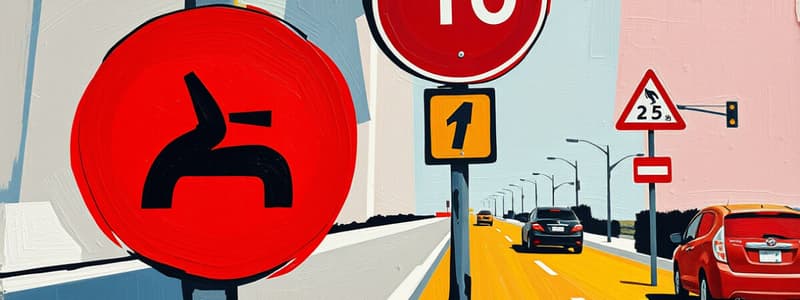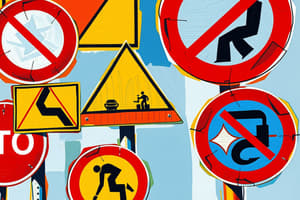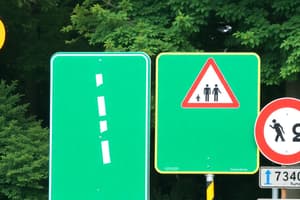Podcast
Questions and Answers
What does a single solid white line between driving lanes in an urban area indicate?
What does a single solid white line between driving lanes in an urban area indicate?
- Traffic on the left is moving faster than traffic on the right
- Lane change is always permitted
- It is a line separating traffic travelling in opposite directions
- Lane changing is not permitted (correct)
What is defined as a 'parking lane' according to driving guidelines?
What is defined as a 'parking lane' according to driving guidelines?
- A lane where parking is allowed but no meters are present (correct)
- The area from the edge of the roadway to the nearest solid white line (correct)
- A lane immediately beside a row of parking meters in an urban area
- A lane usually reserved for bicycles
What does shoulder checking involve?
What does shoulder checking involve?
- Glancing towards the blind spot in the intended direction (correct)
- Only looking into the left outside mirror
- Checking the speed of other vehicles
- Observing the dashboard indicators
What does an illuminated red 'X' in a traffic-lane control light indicate?
What does an illuminated red 'X' in a traffic-lane control light indicate?
What does a sign indicating a 'dangerous goods route' specifically mean?
What does a sign indicating a 'dangerous goods route' specifically mean?
What action should be taken when preparing to make a turn?
What action should be taken when preparing to make a turn?
In driving guidelines, what does the term ‘yield the right-of-way’ mean?
In driving guidelines, what does the term ‘yield the right-of-way’ mean?
What does ‘slippery when wet’ signage indicate?
What does ‘slippery when wet’ signage indicate?
What is the damage threshold above which a driver must report a collision to the police?
What is the damage threshold above which a driver must report a collision to the police?
When stopping behind another vehicle in traffic, what is the recommended action?
When stopping behind another vehicle in traffic, what is the recommended action?
If another vehicle is following too closely, what should a driver do?
If another vehicle is following too closely, what should a driver do?
What should a driver do when recovering from a skid?
What should a driver do when recovering from a skid?
At what speed must a vehicle display a 'slow-moving vehicle' sign?
At what speed must a vehicle display a 'slow-moving vehicle' sign?
Which lane must a driver be in to turn left from a one-way road?
Which lane must a driver be in to turn left from a one-way road?
When turning left at a steady green traffic light, what is the driver's primary responsibility?
When turning left at a steady green traffic light, what is the driver's primary responsibility?
What best describes a 'Weave Zone' on a highway?
What best describes a 'Weave Zone' on a highway?
What does an acceleration lane refer to?
What does an acceleration lane refer to?
What does a flashing yellow traffic light indicate?
What does a flashing yellow traffic light indicate?
Which action should a driver NOT take when stopped behind another vehicle?
Which action should a driver NOT take when stopped behind another vehicle?
Under which conditions is a learner with a Class 7 licence not permitted to drive?
Under which conditions is a learner with a Class 7 licence not permitted to drive?
Which vehicle generally has the right-of-way?
Which vehicle generally has the right-of-way?
What should you do when reversing in a straight line?
What should you do when reversing in a straight line?
What does a sign indicating 'added lane' or 'free flow' mean?
What does a sign indicating 'added lane' or 'free flow' mean?
What does this traffic sign typically indicate?
What does this traffic sign typically indicate?
What is the maximum speed permitted in a rural school zone on a school day, unless otherwise posted?
What is the maximum speed permitted in a rural school zone on a school day, unless otherwise posted?
When passing other vehicles travelling in the same direction on a two-lane highway, a driver should:
When passing other vehicles travelling in the same direction on a two-lane highway, a driver should:
What is the minimum distance a vehicle must be parked from a fire hydrant?
What is the minimum distance a vehicle must be parked from a fire hydrant?
If being followed by a vehicle trying to pass on a two-way road, the driver should:
If being followed by a vehicle trying to pass on a two-way road, the driver should:
What does the sign indicating a construction zone with a flag person ahead suggest?
What does the sign indicating a construction zone with a flag person ahead suggest?
Under what condition is a driver allowed to turn right at a red traffic control light?
Under what condition is a driver allowed to turn right at a red traffic control light?
What does the lane reserved sign indicate?
What does the lane reserved sign indicate?
What should other vehicles do when approaching a stopped vehicle allowing a pedestrian to cross?
What should other vehicles do when approaching a stopped vehicle allowing a pedestrian to cross?
Where should a head restraint be positioned when properly adjusted?
Where should a head restraint be positioned when properly adjusted?
What does the sign indicating 'Caution log trucks turning' suggest to drivers?
What does the sign indicating 'Caution log trucks turning' suggest to drivers?
When a 'PASSING LANE AHEAD' sign is posted, what should a slower moving vehicle do?
When a 'PASSING LANE AHEAD' sign is posted, what should a slower moving vehicle do?
What should drivers understand about a pedestrian crosswalk ahead sign?
What should drivers understand about a pedestrian crosswalk ahead sign?
What action should drivers take upon encountering a sign indicating one-way traffic only?
What action should drivers take upon encountering a sign indicating one-way traffic only?
Flashcards are hidden until you start studying
Study Notes
Turning Procedures
- Signal intention to turn, check for prohibitive signs, stop and yield right-of-way before proceeding.
- Reduce speed prior to the turn and look for cyclists on the right.
- Yield to vehicles if turning left while signaling and reducing speed.
Road Signs
- Certain signs indicate routes for heavy vehicles (above 4500 kg), slow-moving vehicles, or bus lanes.
- A solid white line in urban areas indicates that lane changing is not permitted.
Parking Regulations
- A parking lane is defined as the space closest to the curb, allowing parking without meters, or along a primary highway between roadway edges and solid white lines.
Shoulder Checking and Safety
- Shoulder checking involves glancing into the blind spot in the direction of intended movement.
Traffic Control Lights
- A red "X" above a traffic lane indicates that travel in that lane is prohibited.
Collision Reporting
- Report all collisions to the police if injuries are involved or if damage exceeds $1000.
Following Distances
- When stopping behind another vehicle, allow enough space to maneuver into another lane safely.
Responding to Tailgating
- Gradually slow down to encourage the following vehicle to pass instead of abruptly braking.
Skid Recovery
- When skidding, steer in the direction you want the vehicle to go to regain control.
Slow-moving Vehicles
- Vehicles traveling below 40 km/h must display a “slow-moving vehicle” sign.
Intersection Rules
- At a green light, left turns must not cross in front of approaching traffic until safe; drivers must yield to pedestrians.
Weave Zones
- Weave Zones are areas where entrance and exit lanes are in close proximity, requiring careful navigation between vehicles.
Lane Regulations
- For turning left from a one-way road, use the lane nearest the left curb unless otherwise marked.
Reversing Techniques
- Use inside mirrors for guidance while reversing in a straight line, keeping both hands on the steering wheel.
Acceleration Lane
- An acceleration lane is designed to allow vehicles to merge into highway traffic.
GDL Restrictions
- Learner drivers with a Class 7 licence cannot drive between midnight and 5:00 AM.
Flashing Yellow Light
- A flashing yellow light signals the need to proceed with caution.
Right Turns on Red
- Right turns at red lights are permitted if there are no prohibitive signs and the driver has stopped first.
Pedestrian Crossings
- When a vehicle stops for a pedestrian, other vehicles must not pass it.
Head Restraints
- Properly adjusted head restraints should be level with the top of the ears to provide adequate support.
School Zone Speed Limits
- In rural areas, the maximum speed limit in school zones usually is 50 km/h unless specifically stated otherwise.
Passing Vehicles
- On a two-lane highway, passing should occur on the left when it's safe to do so.
Fire Hydrant Parking Rules
- Vehicles must be parked at least 3 metres away from a fire hydrant.
Construction and Caution Signs
- Various signs, such as those indicating construction or falling rocks, alert drivers to hazards ahead.
Studying That Suits You
Use AI to generate personalized quizzes and flashcards to suit your learning preferences.




